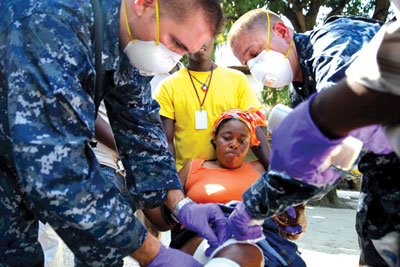 US GOVERNMENT WORKS |
One thing is for certain, it will be impossible to treat everyone who needs medical care after a severe earthquake in Nepal.
Wherever there are functioning hospitals (many hospitals and nursing homes may be reduced to rubble), a triage team will need to be set up to determine how urgently the patient needs to be admitted to hospital.
The next hitch will be the hospital system's capacity to provide adequate resources to meet the needs of the injured. Crush injuries of muscles (rhabdomyolysis) will be one of the most common medical problems encountered after an earthquake, as was the case in Haiti last year. Rhabdomyolysis leads to acute renal failure because the muscle protein is harmful to the kidneys. Depending on how promptly fluid therapy is started, dialysis (artificial kidney) may be necessary for the patient. Unfortunately dialysis is not widely available in Nepal; so even though the patient may be alive, lack of equipment and expertise will conspire to work against him.
Many patients will arrive at hospital with open infected wounds and fractures. Apart from dealing with proper wound care and fracture repair, the patients will need appropriate antibiotics to fight sepsis, common after this kind of a traumatic injury. In Haiti, those who were rescued late and taken to hospital had maggots in their wounds. Healthcare professionals not used to dealing with new and unusual problems will have to consult others, improvise, and learn on the job.
An added problem will be a crush injury leading to gangrene of the limbs that will subsequently need amputation. Amputation will be one of the most common surgical procedures to be performed post-earthquake, as was also the case in Haiti.
Indeed the list of post-earthquake medical problems could be a mile long. Therefore, increasing awareness about earthquake preparedness is obviously useful.
Getting under a desk without running downstairs while the building is shaking will require willpower, but ducking for cover is still the prevalent wisdom of the day. If outside, getting away from buildings and power lines is recommended, but this may be hard to do in the middle of Indra Chowk. Given the rate at which dubiously built high-rise structures are being developed, it's questionable how committed Nepal is to earthquake preparedness.
How does the adage go, live and learn? Let's hope we live to learn.
READ ALSO:
Geo-political instability, EDITORIAL
Not if, but when, KUNDA DIXIT
"Let's learn from Haiti"
"Doing nothing is not an option"


